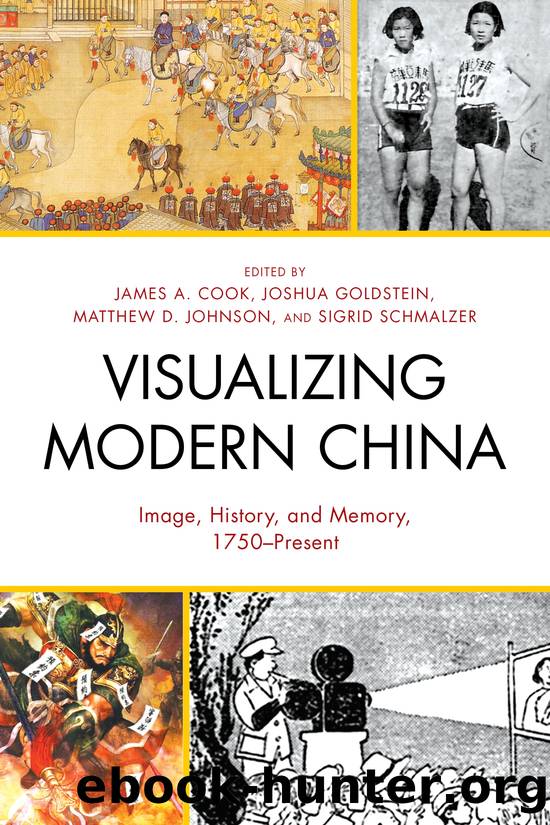Visualizing Modern China: Image, History, and Memory, 1750âPresent by Cook James A. Goldstein Joshua Johnson Matthew D. Schmalzer Sigrid

Author:Cook, James A.,Goldstein, Joshua,Johnson, Matthew D.,Schmalzer, Sigrid
Language: eng
Format: epub
Publisher: Lexington Books, a division of Rowman & Littlefield Publishers, Inc.
Figure 8.8 Still from the climax of the film Twin Sisters (Zai sheng hua) in which the two sisters played by Hu Die share the screen. The film touches on many of Chinaâs social problems in the 1930s, including the disparities between rich and poor and the high-handed treatment of the poor by the rich. The above image is a good example of representations that raises these class tensions but is certainly far from a clear promotion of class revolution or an unequivocal âleftistâ message.
Upon its release, the film immediately became a hit. Indeed, The Twin Sisters has been ranked as one of the six most popular films in the entire history of Chinese filmmaking.35 Many critics also lauded the film. Some praised its realistic portrayals of the hardships suffered by the ordinary people and its exposure of the ugly side of the rich and powerful; others appreciated the filmâs craftsmanship and technical sophisticationâthe Chinese film industry was undergoing the transition from silent to sound, and The Twin Sisters demonstrated Chinese filmmakersâ mastery of the new technology. The female lead, Hu Die, who played both of the twin sisters in the film, also received plaudits. Letters from fans poured in demanding the studio make a sequel.36
The GMD government praised the film as well. It won best sound film in 1934.37 A year later, the Nationalist government included the actress Hu Die in a delegation to represent Chinaâs film industry at Moscowâs International Film Festival and the film was submitted as an entry. Indeed, it is not hard to understand why âright-wingâ members of the official establishment often liked The Twin Sisters. First, the film is explicitly set in 1924, the warlord era, thus relegating its depiction of human suffering to the historical past. It thus avoids directly implicating 1930s Chinese reality or the GMD. Indeed, the original version of the film includes a scene where Dabaoâs husband helps to distribute GMD newspapers and pamphlets espousing Sun Yat-senâs Three Peopleâs Principles (the central credo of the GMD) thereby portraying the GMD as liberators of the oppressed masses.38 Chinaâs misery is placed at the doorstep of warlords and foreign imperialists; many of the misfortunes integral to the plot (the original abandonment of the twin sisters and their separation, the death of Dabaoâs father-in-law) are blamed on the violence of foreign arms smuggling. For such reasons, the âright-wingâ establishment could comfortably shower the film with honors.
By the same token, many leftist intellectuals disapproved of the film precisely because in their view it failed to address the domestic roots of Chinaâs problems. Despite the focus on class issues, the solution the film proposes to resolve class conflict is, in the words of one critic, âto be reconciliatoryâ (tiaohe zhuyi de taidu) rather than resist exploitation.39 In particular, when Dabao fumes against the exploitation of the poor by the rich, her mother (in many ways the filmâs ultimate heroine) repeatedly admonishes her: âWe poor people are born poor. Please learn to be patient and accept your fate.
Download
This site does not store any files on its server. We only index and link to content provided by other sites. Please contact the content providers to delete copyright contents if any and email us, we'll remove relevant links or contents immediately.
Wonder by R.J. Palacio(8430)
Mastering Adobe Animate 2023 - Third Edition by Joseph Labrecque(3720)
Unlabel: Selling You Without Selling Out by Marc Ecko(3574)
Ogilvy on Advertising by David Ogilvy(3485)
Hidden Persuasion: 33 psychological influence techniques in advertising by Marc Andrews & Matthijs van Leeuwen & Rick van Baaren(3454)
Drawing Cutting Edge Anatomy by Christopher Hart(3440)
The Pixar Touch by David A. Price(3347)
POP by Steven Heller(3297)
The Code Book by Simon Singh(3057)
The Art of War Visualized by Jessica Hagy(2932)
Slugfest by Reed Tucker(2924)
The Curated Closet by Anuschka Rees(2897)
Rapid Viz: A New Method for the Rapid Visualization of Ideas by Kurt Hanks & Larry Belliston(2815)
Stacked Decks by The Rotenberg Collection(2796)
365 Days of Wonder by R.J. Palacio(2737)
The Wardrobe Wakeup by Lois Joy Johnson(2717)
Keep Going by Austin Kleon(2682)
Tattoo Art by Doralba Picerno(2583)
Tell Me More by Kelly Corrigan(2579)
